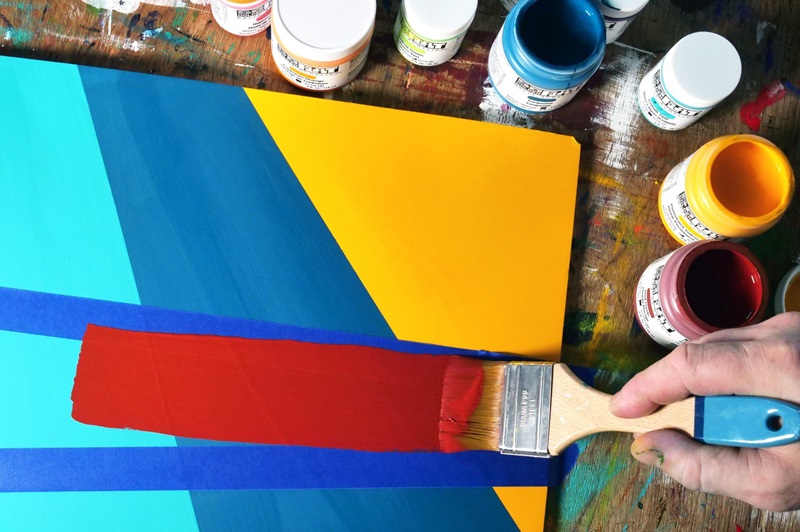Art brushes play a crucial role in the creative process for artists and painters, influencing the outcome of their work in several significant ways. Different brush shapes and sizes allow artists to achieve various levels of precision. Fine-tipped brushes, such as rounds, are essential for intricate details, while broader brushes, like flats, are great for covering larger areas. A diverse set of brushes provides artists with versatility in their techniques. From creating bold strokes with flat brushes to blending seamlessly with softer brushes, artists can express a wide range of styles and moods.
Brushes with varying bristle types and shapes contribute to the creation of different textures and effects. Stiff brushes can produce visible brushstrokes, while softer brushes may be used for smoother blend. Artists often work in layers to build depth in their paintings. Different brushes aid in layering paint, allowing artists to develop nuanced compositions and achieve a sense of three-dimensionality. The choice of brushes is a personal and expressive aspect of an artist’s style. Whether favoring bold strokes, delicate lines, or textured effects, artists can convey their unique artistic voice through their brushwork.
Different Types of Art Brushes for Painting
1. Flat Brushes

Flat brushes are among the most prevalent varieties of paint art brush that are a must-have for any artist. The bristles are compressed and the bracelet containing them on this brush is completely flat, allowing the bristles to be distributed in a rectangular pattern. Long-haired “One Stroke” brushes are a prevalent variety of flat brushes that retain more paint. Without difficulty, flats can be applied to virtually any painting medium. Nevertheless, their primary functions consist of merging, washing, and shading. Its uniform and flat bristles make it the ideal brush for drawing landscapes and heavens with wider strokes, as well as for producing thinner lines and more seamless colour transitions. Among its numerous applications are floating, stroke work, base coat application, varnishing, and more.
2. Wash Brushes
If you ever purchase a set of paint art brush and notice that one appears to be larger than the others, that brush is most likely the wash brush. The construction of these extremely broad, flat brushes allows them to retain surplus paint, pigment, or water. Wash brushes are predominantly employed to rapidly cover larger areas of paper or canvas. Additionally, these thicker brushes are highly advantageous for the purpose of collecting minor quantities of surplus paint or water that may have befallen the artist’s canvas. Wash brushes are typically employed to apply colour in the form of solid backgrounds or expansive, square-shaped areas.
3. Angled Brushes
Although classified as a flat brush, the angled brush is distinguished by its hairs, which are angled to suit the specific purpose it serves. Slanted or angled ends make these brushes particularly advantageous for contouring, delineating, and applying to shapes with varying degrees of thickness and coverage. Simply put, the flexibility of these brushes enables the artist to transition from dense to thin with a single stroke. The angled brush is predominantly employed to produce curved, precise, and varied-sized lines; for instance, it is utilised to draw petals and foliage. Atypically, flat brushes lack the precision required to draw intricate curves and lines; in this regard, angled brushes prove to be superior.
4. Fan Brushes
A short, flat ferrule organises the filaments of a fan brush in a configuration resembling that of a fan. Upon using this fan brush, you will immediately be able to depict grasses, shrubs, trees, and other abstract aquatic designs with acrylic paints that you have previously found difficult to draw. Fan brushes, owing to their fan-shaped tips, exhibit exceptional qualities for both merging and applying delicate highlights to more subdued areas of a painting. Additionally, you can experiment and produce a variety of textures using a fan brush. For instance, the effect produced by delicately tapping the brush differs from that of a long, straight stroke. While these brushes are frequently linked to the acrylic depiction of natural elements such as heavens, landscapes, and more, they can also be employed to generate remarkable textures and a variety of designs.
5. Circular Brushes
Round brushes are those that possess a round ferrule, with the hair ends being either pointed or rounded in certain instances. Typically considerably smaller in size than angled and flat brushes, these brushes feature a gentle, circular tip. These spherical brushes are primarily utilised to acquire proficiency in brush control. These brushes are ideal for detailing, filling, and producing broad lines; they can also be used to fill in small areas. Widely favoured in acrylic painting, rounded brushes offer optimal control for various types of details. Furthermore, the slender design of the handles of these brushes renders them flexible, resembling the feel of gripping a pencil or pen. When an artist desires complete authority over the paint’s flow and consistency in size, a round brush is an indispensable instrument.
6. Liner Brushes

Constantly referred to as the high-liner or outliner, the liner brush consists of elongated filaments and is incredibly thin; it resembles a round brush in appearance but is considerably more diminutive and slender. Liner brushes are typically distinguished by their long ferrules and thin (long or short) filaments, which render them ideal for applying precise strokes and movements, particularly in the context of intricate lettering art. Liner brushes are ideal for detailing, lettering, and producing thin, continuous, and delicate strokes due to their slender and streamlined composition. Due to the minuscule size of the brush’s tip, it is an ideal instrument for appending signatures, numbers, words, and delicate details to a work of art. In most cases, ink (for signatures) and oil or acrylic paint can be utilized in conjunction with liner.
7. Bright Brushes
The brilliant brush is a type of short-bristled brush that shares flat ferrules with the flat brush. A bright brush, on the other hand, is distinguished by its flat ferrule, inwardly curved edges at the point, and shorter bristles. Typically, this distinguishes it from a standard flat brush. As they retain less water than wash brushes, brights are typically well-suited for use with acrylic, oil, and decorative mediums. Bright washes are ideal for applying paint in precise, brief strokes and are primarily employed for blending. It functions exceptionally well with denser and heavier pigments, making it an ideal instrument for precise work, dry brushing, producing scratchy strokes, and dabbing (constraint, brief strokes). Frequently, these brilliant brushes are also employed to salvage any type of sloppy painting.
8. Filbert Brushes
Filbert brushes are long, rounded-tipped, flat brushes with filaments. Filberts, which have chiselled round-edged bristles and a thick, flat ferrule, are capable of holding a considerable quantity of water, rendering them ideal for use in washing processes. Due to the cohesive nature of the bristles when moist, these brushes can also be utilised for blending and stroking. The Filberts brush is unrivalled as a base coating instrument due to the incorporation of ridge-free bristles resulting from their cylindrical shape. Filberts are favoured by figurative painters because they produce a variety of markings, from broad to linear, without the square edges of flat brushes. In addition to being utilised by professionals for blending and applying colour treatments, filtration screens retain a considerable quantity of water. In conclusion, Filberts are most effectively utilised to fill in rounded regions and to create rounded strokes for leaves, petals, flowers, and avian feathers.